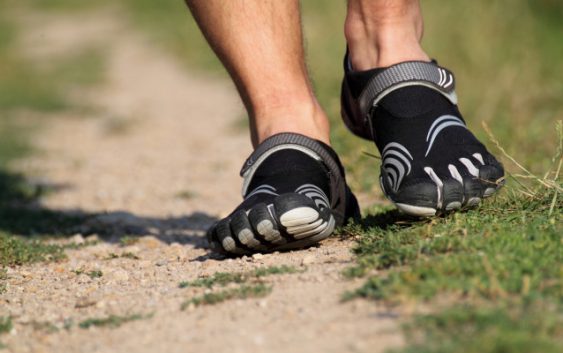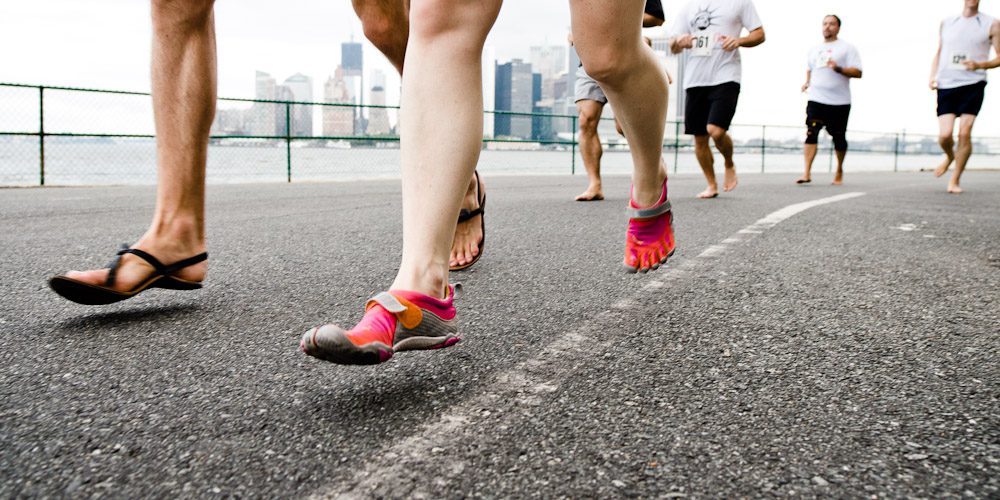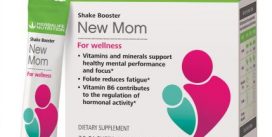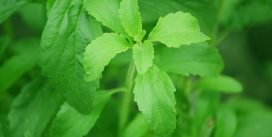Beginner’s Guide to Barefoot Running

Hey Let’s Run! … Barfoot
Barefoot running, also known as minimalism or natural running, is simply running without shoes or running in thin-soled shoes. Running barefoot is considered to be the natural way of running and some entire cultures still foster this idea such as the Tarahumara in Mexico. Minimalists, or runners who run in minimal shoes or barefoot, argue barefoot running can correct a runner’s form and foster a forefoot strike, which can result in fewer running injuries than those who run with a heel-strike.
However, scientific research has yet to reach a clear consensus on the benefits of barefoot running. Barefoot running advocates argue minimal running is better for the feet in that it strengthens them and reduces chronic injuries such as IT Band Syndrome, Runner’s Knee, shinsplints and other common running injuries. According to these proponents, barefoot running forces runners to forestrike as opposed to heel-strike, which is the result of the evolution of the running shoe to exhibit a cushioned heel.
Barefoot running remains a controversial topic and many argue it might not be suitable for all runners. Runner’s World Editor-in-Chief, David Willey, wrote about barefoot running in a 2011 editorial and summed up barefoot running by stating, “There’s no single answer or prescription that’s right for every runner when it comes to footwear and running form.”
In 1960 Ethiopia’s Abebe Bikila, the greatest Olympic marathoner of all time, won the first of his consecutive gold medals sans shoes in a world record 2:15:17. While Bikila was making Olympic history, England’s Bruce Tulloh was running European record times from 1955 to 1967, almost always in bare feet. He ran 13:12 for three miles on grass, and 27:23 for six miles on cinders. Later, Tulloh taught in Africa, coached, wrote books, and ran solo across America (2,876 miles, albeit in shoes).
Charlie “Doc” Robbins and Zola Budd are two more important contributors to barefoot running. Robbins, winner of two USA National Marathon Championships in the late 1940s, completed 50 straight Thanksgiving Day Road Races in Manchester, Connecticut, before calling it quits two years ago. Most Thanksgivings, Robbins went shoeless, though he would resort to a pair of socks if the temperature dipped below 20 degrees. Mention the name Zola Budd to the casual track fan and you’ll likely get one (or all) of three responses: Barefoot. South African. Tripped Mary Decker. Budd set a track world record in January 1984 when, just 16, she ran 5000 meters in South Africa in 15:01.83, more than six seconds under Mary Decker’s existing record.
Still, it wasn’t until 2009 that barefoot running became a hot topic. The biggest impetus was Christopher McDougall’s book Born to Run. While ostensibly the story of Mexico’s Tarahumara Indians—who run barefoot or in tire-tread huaraches—controversial chapters in the book conclude that running shoes have done little to prevent injuries. The popularity of minimal shoes, such as the Nike Free and Vibram FiveFingers, has fueled the fire.
In terms of racing, studies have proven that less weight on your feet will improve your running efficiency and decrease your time. Research has also shown that barefoot running forces the foot to impact the ground differently. Running shoes typically make runners strike the ground with their heel first, whereas barefoot running changes the gait to a forefoot strike. Many barefoot runners say they are more comfortable with the change though, since the forefoot strike is a natural motion for most runners. But for runners who are naturally rearfoot strikers, barefoot runs can put stress on the Achilles tendon and lead to injuries. For the average runner, the benefits may not outweigh the advantages when it comes to barefoot running. Because of the higher risk of puncture wounds, infection and other potential injuries, many podiatrists and doctors, like sports podiatrist-biomechanist Kevin Kirby, suggest incorporating barefoot running into your routine, rather than ditching your shoes altogether.
The more minimal a shoe the more your foot, ankle and lower leg have to work to maintain and support your body in motion. This mean the foot, ankle and calves have to be stronger. While minimalism may not be for all runners, most runners can benefit from strengthening their lower leg. Whether you’re trying to transition to barefoot running or just trying to build strength, the transitioning process is beneficial to all runners.
Following the boom of barefoot runners, running shoe companies such as Nike, New Balance, Saucony and most notably, Vibram with the FiveFingers shoe, began making minimal shoes. Minimal running shoes are an alternative for runners who want to try barefoot running but also want to protect their feet from dirt, water, rocks and other roads hazards. The barely-there nature of the shoes put little between you and the ground, imitating barefoot running so you don’t have to put your vulnerable soles at risk.
Many have said, “It hurts so much to run with shoes, it must hurt more to run barefoot!”
If it would hurt to run barefoot, the way you run with shoes, then you aren’t running in shoes the way humans are designed to run!
Worse yet, if it hurts to run the way you run while wearing shoes… your shoes aren’t doing what you probably expect them to do – in other words, you’ve throw away your money, and if those are not the first pair of shoes you’ve bought – you’re acting like an absolute fool! … unless you get all your shoes free.
More to-the-point, you aren’t responding appropriately to that pain that is caused by running badly. Experiment – or play, like a child – while adjusting the way you run, so that Running Barefoot becomes very gentle, very efficient, and comfortable! … or at least “bare-able”…
Remember, there will be a lot of fine tuning as you learn to run barefoot. However, since many of you have been handicapped, by wearing shoes for a long part of your life, you most likely have learned how to run with many bad habits. It should be desirable to let go of those many bad habits and start, as an infant at the beginning.
Now that you let it go, you can start at the beginning and experiment, first with standing, feeling, discovering, with the same wonder and curiosity as an infant. Then move on, gradually, to walking, and again, experimenting, discovering, wondering, feeling how things are working. And, finally, to running, again, pay attention to what your feet and body tell you, as you experiment, discover, and run with great curiosity.
For those who want to move along more quickly, I will share with you what I have learned from listening to my bare soles for more than half-a-century… You should still experiment and test these techniques out on your own bare soles. Basically what we taught you in Barefoot Running Step by Step:
 Running and walking are about moving our body forward! Moving our body forward is where we should start. Most of the details above will fall into place if we simply focus on a point somewhere out in front of us, and move our body towards that point.
Running and walking are about moving our body forward! Moving our body forward is where we should start. Most of the details above will fall into place if we simply focus on a point somewhere out in front of us, and move our body towards that point.
Don’t worry about cadence, stride length, foot landing, etc. at least not for now. Those are things you should have learned before.
To avoid up-and-down bouncing, we’ll need to lower our body and bend our knees so that our body can maintain a more-or-less constant height while our legs move underneath our body. And we’ll want to avoid trying to launch our body by pushing off, and instead simply lift our feet, one-at-a-time, of course – unless you want to practice “hopping” technique – but that’s a whole other method, and not a very efficient way to travel (except for bunnies and kangaroos and some bugs too).
Then we’ll need to counterbalance our hip rotation by rotating our upper torso in the opposite direction – this also reduces how much we need to swing our arms to counterbalance the alternate movement of our legs.
To continue moving forward, we’ll want to face forward; not the ground; not with our head swiveling form side-to-side; and certainly not with our head bouncing all over the place (I’ve seen runners doing just that).
 What’s so important about relaxing? The alternative is to tense up. When we’re tense, we’re more rigid. If we’re more rigid, then we’ve lost all that marvelous springiness in our body, which naturally eliminates injurious impact. This springiness is the very thing we gain, when we can feel how painful being rigid hurts while running badly (especially in bare feet).
What’s so important about relaxing? The alternative is to tense up. When we’re tense, we’re more rigid. If we’re more rigid, then we’ve lost all that marvelous springiness in our body, which naturally eliminates injurious impact. This springiness is the very thing we gain, when we can feel how painful being rigid hurts while running badly (especially in bare feet).
We’ll also want to keep our torso mostly vertical, so that our upper torso doesn’t pull us into the road face-first! (this is really just more elaboration about facing forward) Nor do we want our torso pulling us backwards … since that isn’t the direction we’re trying to run, at least not right now. Hmm… maybe that could be another chapter in itself?
If you are looking for theses amazing shoes (I love them!) go here and get the greatast selection: http://amzn.to/1LpHS8q
__________________________
Independent Herbalife Member - Healthy FooD Nutrition Blog
Buy Authentic Herbalife Products Online :
*Fast Shipping directly from Herbalife Plant
*Freshest Herbalife Products Guaranteed
*Full Service
>>Click here and Get The Best Quality and Service Available 
Feel free to contact me! Fill the form below


